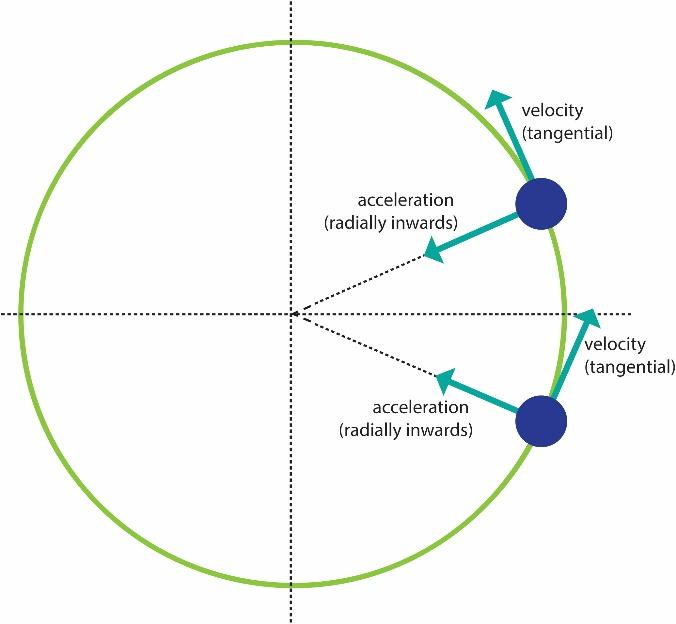
Uniform circular motion is called continuously accelerated motion mainly because its:
1.) direction of motion changes
2.) speed remains the same
3.) velocity remains the same
4.) direction of motion does not change
Answer
510.6k+ views
1 likes
Hint: A change in either the magnitude or the direction constitutes a change in the velocity.
Complete step by step answer:
Uniform circular motion can be described as the motion of an object in a circle at a constant speed. As an object moves in a circle, it is constantly changing its direction. At all instances, the object is moving tangent to the circle. Since the direction of the velocity vector is the same as the direction of the object's motion, the velocity vector is directed tangent to the circle as well.
An object undergoing uniform circular motion is moving with a constant speed. Nonetheless, it is accelerating due to its change in direction. The direction of the acceleration is inwards. The final motion characteristic for an object undergoing uniform circular motion is the net force. The net force acting upon such an object is directed towards the center of the circle. The net force is said to be an inward or centripetal force.
Without such an inward force, an object would continue in a straight line, never deviating from its direction. Yet, with the inward net force directed perpendicular to the velocity vector, the object is always changing its direction and undergoing an inward acceleration.
Uniform circular motion is accelerated because the velocity changes due to continuous change in the direction of motion. So, even when the body moves at a constant speed, its velocity is not constant. Thus, for a body moving in a circular path at a constant speed, its velocity changes continuously. The change in velocity gives rise to an acceleration in the moving body.

Therefore, circular motion is an acceleration motion even when the speed remains constant. An accelerating body is an object that is changing its velocity. And since velocity is a vector that has both magnitude and direction, a change in either the magnitude or the direction constitutes a change in the velocity. Hence a uniform circular motion is an accelerated motion because direction of motion keeps on changing.
So, the correct option is A i.e., direction of motion changes.
Note: In uniformly circular motion direction is changing at uniform rate depending upon the speed of the body. Students must have clarity between the difference in velocity and speed. Speed is the magnitude of the velocity. That is, it is directionless.
Complete step by step answer:
Uniform circular motion can be described as the motion of an object in a circle at a constant speed. As an object moves in a circle, it is constantly changing its direction. At all instances, the object is moving tangent to the circle. Since the direction of the velocity vector is the same as the direction of the object's motion, the velocity vector is directed tangent to the circle as well.
An object undergoing uniform circular motion is moving with a constant speed. Nonetheless, it is accelerating due to its change in direction. The direction of the acceleration is inwards. The final motion characteristic for an object undergoing uniform circular motion is the net force. The net force acting upon such an object is directed towards the center of the circle. The net force is said to be an inward or centripetal force.
Without such an inward force, an object would continue in a straight line, never deviating from its direction. Yet, with the inward net force directed perpendicular to the velocity vector, the object is always changing its direction and undergoing an inward acceleration.
Uniform circular motion is accelerated because the velocity changes due to continuous change in the direction of motion. So, even when the body moves at a constant speed, its velocity is not constant. Thus, for a body moving in a circular path at a constant speed, its velocity changes continuously. The change in velocity gives rise to an acceleration in the moving body.

Therefore, circular motion is an acceleration motion even when the speed remains constant. An accelerating body is an object that is changing its velocity. And since velocity is a vector that has both magnitude and direction, a change in either the magnitude or the direction constitutes a change in the velocity. Hence a uniform circular motion is an accelerated motion because direction of motion keeps on changing.
So, the correct option is A i.e., direction of motion changes.
Note: In uniformly circular motion direction is changing at uniform rate depending upon the speed of the body. Students must have clarity between the difference in velocity and speed. Speed is the magnitude of the velocity. That is, it is directionless.
Latest Vedantu courses for you
Grade 11 Science PCM | CBSE | SCHOOL | English
CBSE (2025-26)
School Full course for CBSE students
₹41,848 per year
Recently Updated Pages
Master Class 9 General Knowledge: Engaging Questions & Answers for Success

Master Class 9 English: Engaging Questions & Answers for Success

Master Class 9 Science: Engaging Questions & Answers for Success

Master Class 9 Social Science: Engaging Questions & Answers for Success

Master Class 9 Maths: Engaging Questions & Answers for Success

Class 9 Question and Answer - Your Ultimate Solutions Guide

Trending doubts
State and prove Bernoullis theorem class 11 physics CBSE

Who built the Grand Trunk Road AChandragupta Maurya class 11 social science CBSE

1 ton equals to A 100 kg B 1000 kg C 10 kg D 10000 class 11 physics CBSE

State the laws of reflection of light

One Metric ton is equal to kg A 10000 B 1000 C 100 class 11 physics CBSE

Difference Between Prokaryotic Cells and Eukaryotic Cells




